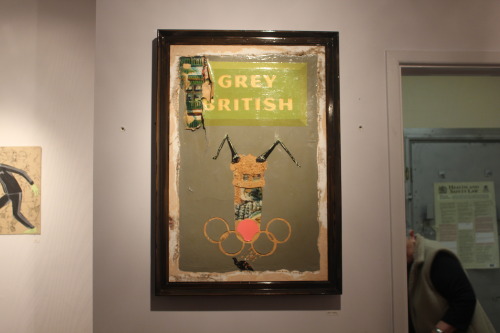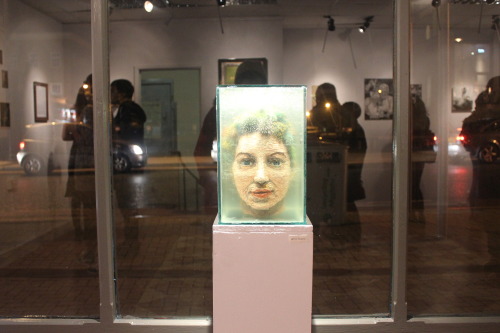The opening night was on Saturday 19th October, and Ivor House was transformed into a great space to showcase some fantastic art and music. Before discussing the art, the music needs a special mention; there was a wild, wondrous contrast between the musicians selected for the show. The warm-hearted, folk-tinged ditties of Seamus Fogarty's unplugged set were superbly followed by Ginko's atmospheric, instrumental soundscapes. Both performances were wonderfully captivating, and the basement made for a memorable setting.
 |
| Seamus Fogarty (image courtesy of Modern Alchemists) |
 |
| Ginko (image courtesy of Modern Alchemists) |
Beginning with a focus on drawing, there is great work on both floors. Upstairs features Bianca Theresa's intricate, engaging pencil portraits on a modest scale, displayed sweetly on a line of string. They appear to blur the borders between reality and fiction, as though the artist has fabricated certain aspects of her subjects' appearance. Downstairs, Sophie Adams' perplexing line drawings are impossible to look away from, similarly featuring surreal, made-up characters such as a reclining human with the head of a cat. With work on both floors, Jo Higgs' colourful, naive drawings of dis-proportioned nudes conjure up a playful, childlike narrative. Back upstairs, there is the discordant work of Laurence Elliott. Here he presents two mixed media drawings in monochrome. Fitting with Elliott's established visual code, the works are at once domestic and scientific, blending the familiar, yet slightly awkward aesthetic of family snapshots with confrontational anatomic motifs - the devil is truly in the detail.
 |
| Bianca Theresa's drawings (image courtesy of Joshua Kendall) |
Building on the eclectic display, there are a select number of canvases. Matt Redman's work fondly recalls Peter Blake's mixed media pieces to brilliant effect. The slogan 'Grey British' heads the canvas and is rendered, as well as the rest of its surface, in an illustrious, varnished palette of muted greens and greys. Also featured is a small piece by Helen Bur. It is engulfed in mystery; an ambiguous industrial scene is depicted, yet the painterly, organic marks lend the piece an ethereal quality which works to brilliant effect.
 |
| Matt Redman's 'Grey British' (image courtesy of Joshua Kendall) |
Sculptural works play a key part in the show: Alex Waddell's hand carved figures remember the skilled work of puppeteers and toy-makers from a by-gone era, while Laura Jane Kitts' geometric, leather sculptures are intriguing pieces of craftsmanship - perhaps questioning the use of leather in a seemingly purposeless object. Downstairs, Sarah Younan's impressive ceramic heads are a treat. The process involved in their creation is fascinating enough, but the whimsical, delicate illustrations and text overlaid on the ceramics are curious and thoughtful. Also featured downstairs is Rebecca Wyn Kelly's assemblage of miniature figurines and toys - a flurry of nostalgia and surrealism. The scene is set for some strange, cowboy-vs-Indians, holiday-in-suburbia showdown, and we can only imagine the results of such. Next to this is James Green's latest masked invention: a combination of machismo, Kendo Nagasaki aesthetic and 'here's-one-I-made-earlier' Blue Peter effort, which contrasts brilliantly. The familiar, tribal pattern of the wrestler's mask is offset by the everyday materials used: flannel socks, a fabric sports bag and beads which make for an enthralling piece.
 |
| Arron Kupier's painting-sculpture (image courtesy of Joshua Kendall) |
Certain work on show is an amalgam of two, occasionally disparate, art forms. Arron Kupier's fascinating painting-sculptures are highly inventive in their construction. The method involves syringing paint into a chamber filled with a gel-like substance, which is surely a painstaking and laborious process, the outcome of which is an unfamiliar, painterly-yet-three-
All-in-all, this year's 'Hand of Roath' has been excellently appropriated by the Modern Alchemists, with a wealth of talent featured, going to show that truly wonderful things can be built from the ground up - a massive congratulations to the guys behind the scenes, future output is eagerly awaited!














